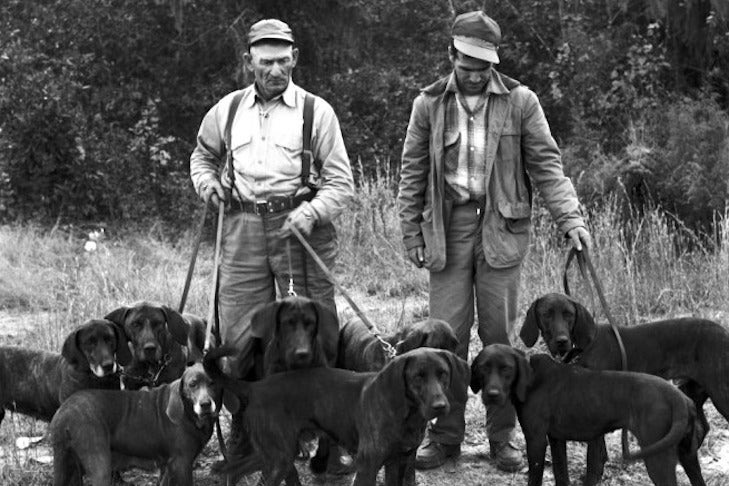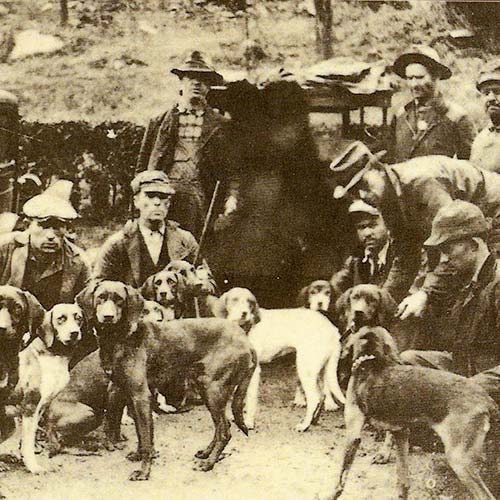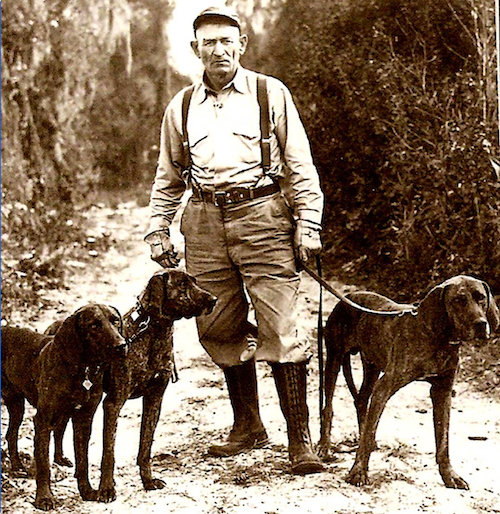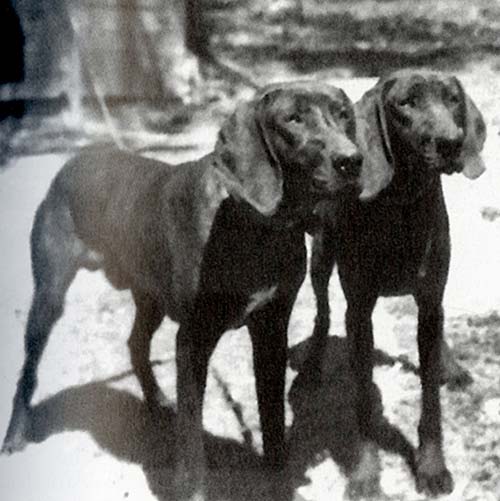
Dogs can teach us a nation’s history as surely as any textbook. Trace the history of the coonhound, for example, and you’ll find a master class on how our fledgling nation flourished.
The very first Americans were British, and so too were their dogs. But as America’s hounds evolved, they changed dramatically, just like the colony their masters founded. Heavy-boned English Foxhounds turned into more agile and speedy American Foxhounds, which in turn provided a foundation for the various coonhounds, each of which represented a different part of the expanding American landscape, and the needs and preferences of settlers pushing forward into the frontier.
Among the six officially recognized AKC coonhound breeds, there is just one that does not trace its lineage back to British breeds that accompanied the earliest colonists. In dogs, at least, the Plott Hound is the ultimate American immigrant, arriving in the mid-1700s with its German masters.
The Plott Brothers
Even the most cursory visual comparison between the Plott and his adoptive coonhound cousins underscores those differences in their backgrounds: While the other British-derived coon dogs have soft, pleading expressions that would not look out of place beside a roaring Yorkshire fireplace, the Plott has a confident, determined gaze, as if ready to be loosed in the Black Forest to defend himself against tooth, tusk, and claw.
The same kind of pluck in the face of unknown challenges was required of the Plott brothers in 1750, when they set sail for America with their five hunting dogs.
No one quite knows precisely why the two teenagers – some say they were twins – made the difficult transatlantic journey. Because the Plott family had a long history as gamekeepers in the Rhine Valley, some speculate that the young men had been hired to be contract hunters in the Smoky Mountains of North Carolina.
One of the two brothers, Enoch, died while crossing the Atlantic. His surviving 16-year-old brother, Johannes, whose name was later Anglicized to George, made the trip to Appalachia on his own, presumably speaking minimal to no English.
The quintet of hounds that he brought with him – at least some of which were brindled – had a similar reservoir of tenacity and grit, necessary qualities for dogs developed to hunt the wild boar that is so prevalent in the forests of southern Germany.

All In The Name
As with the details of the Plott brothers themselves, no one quite knows the exact background of their hounds, though it’s likely they were derived at least in part from Hanoverian Schweisshunds, tracking dogs whose roots go back to medieval bloodhounds. German hunters are particularly ritualistic and unyielding about proprieties of the hunt, including tracking down any wounded game to ensure it does not suffer unduly. As a result, breeding dogs like the Hanoverian – with excellent noses that could track even days-old trails – was a high priority. Like the Plott Hound, the Hanoverian is medium-sized and often brindle, though it is noticeably shorter-legged.
Eventually, George Plott and his hounds arrived safely in New Bern, North Carolina. While he moved frequently throughout his life, one constant was the dogs, which through succeeding generations became a birthright of sorts. Packs of dogs were handled down from father to son, same as a valuable piece of land or a treasured family bible.
In the early 1800s, George Plott’s son Henry settled in Haywood County in western North Carolina. The valley in which he settled, the creek beside the home he built, and the rugged mountains that provided a picturesque backdrop – all three would eventually take on the Plott name. In that game-rich locale, he began to standardize what was to become the only breed developed in North Carolina and, eventually, its official state dog. And it too, like so much of the natural landmarks surrounding him, became indelibly associated with his family name.

Big Reputation
In this newly settled frontier, Plott’s dogs proved to be good all-around farm dogs, protecting humans and animals alike, and helping neighboring farmers dispatch predators. At home, the Plott Hounds were gentle with children and respectful of livestock, even herding cows, pigs, and horses when necessary. But in the mountains behind the Plott homestead, the keen-nosed hounds hunted mountain lion and bear with legendary fearlessness. That ferocity was matched only by the breed’s intelligence, which tempered any rashness and allowed them to live to hunt another day.
By the latter half of the 1800s, savvy hunters started seeking out these Plott bear dogs, though the family did not relinquish them freely. Their reputation as the ultimate big-game dog was cemented in 1935, when Branch Rickey – the same baseball executive responsible for bringing Jackie Robinson to the sport – contracted Von and Little George Plott to guide him on a bear hunt. Over three days, the dogs and hunters “jumped” 20 bears and killed eight, six of them in one record-setting day.
As the breed’s popularity grew, so did the disagreements among its breeders, both within the Plott family and outside of it. In any breed that had only five foundation dogs, crossbreeding to bring in fresh blood was inevitable – as were the resulting differences of opinion.

Plott Hounds Today
Some breeders embraced so-called “leopard Plotts,” whose infusion of cur blood gave them their signature bluish-gray spotted coat; others rejected them as inauthentic. Later hound crosses included local Blevin Hounds, which were tan with black markings, giving rise to the buckskin color and black saddles sometimes seen in the breed.
Even the word “Hound” in the breed name was contested, with some Plott aficionados arguing that it wrongly emphasized the qualities of the other British-derived coonhounds and discounted the breed’s cur blood.
No matter what they were ultimately called, the Plott family’s hounds are inextricably linked to the history of western North Carolina. In the mid-1800s, the Swiss geographer Arnold Guyot, who charted the topography of the entire chain of Appalachian mountains, was guided by Amos and Enos Plott (George’s grandsons), their trusty hounds in tow.
Despite the Plott Hound’s presence in North Carolina since colonial times, the breed is not well known there, with some fanciers reporting that their dogs are sometimes mistaken for skinny, striped Labrador Retrievers. Nationally, they is perhaps even less of an awareness of the breed, which was only recognized by the American Kennel Club in 2007.
Not that Plott fanciers are unduly concerned about that lack of visibility. Many Plott Hounds today are still hunting dogs, preferring the conifer-carpeted woods to the rubber mats of dog-show rings – an opinion that happens to be shared by many of their devoted owners. Closely held and appreciated by those who know them, the Plott Hound has survived more than three centuries thanks in large part to those who have been quite happy to keep them on the trail and out of the spotlight.

